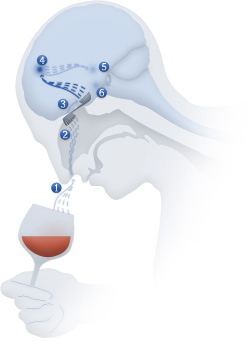Smell
Smell is very important in assessing wine. The olfactory receptors (located in the upper part of the nasal cavity) are very sensitive to the aromas and are directly connected to our brain’s image archive. When we smell wine, we access our image bank (which is more or less extensive, according to our experience) and try to describe the wine’s components.
Wine Aromas
There are two ways of assessing a wine’s aromas: one with the wine resting on the glass and another slightly swirling the glass. The aromas released help assess the wine’s intensity (low, medium, pronounced), phase of evolution (young, old, tired, oxidised) and character (fruity, floral, vegetable, etc). The wine’s aromas can also be assessed with an empty glass. The assessment of the glass bottom evaluates the persistence of the aromas when they are not in contact with alcohol.
The so-called wine aroma wheel helps one describe the aromas found in a wine. It consists of a coloured circle divided into three sections: in the centre are the general terms, which become more specific as one reaches the circle’s perimeter (for instance, fruity, tree fruit, apple). The aroma wheel presented fits to wines produced in Portugal and is only intended to help qualify a wine’s aromas. This is not an extensive aroma wheel: it only presents the most common aromas found in Portuguese wines.
A wine’s aromas can be classified as:
– primary: the aromas from the grape variety, which give a special character to the wine. Among other factors, these aromas depend on the region and the grapes’ degree of ripening.
– secondary: the aromas resulting from fermentation and the action of yeasts on the must. Such aromas are influenced by the yeasts’ compounds and fermentation conditions, such as temperature.
– tertiary: the aromas resulting from ageing, whether in wood and bottle or just in bottle. The ageing process originates complex aromas, which form the wine’s bouquet. The bouquet can have an oxidising character (during ageing, oxygen passes through the wood pores and oxidises the wine) or a reducing character (the aromas develop in the bottle, protected from air).
Some grape varieties, as, for instance, Moscatel, have intense primary aromas. Others, as Trajadura, have primary aromas of little intensity.
As a wine’s aromatic compounds are quite numerous, they were grouped into sets of aromas based on proximity. Besides the aromatic groups there are some basic terms that help characterise a wine aromatically. A wine with good aromatic characteristics can be qualified as fine, pleasant, harmonious, etc. When a wine has lesser aromatic qualities, it is qualified as: common, unpleasant, weak, defective, spoiled, etc.
Interesting Links to explore your olfactory ability:
Buy box with wine aromas & defects»
Download here the Aroma Wheel by the Infovini team»
Source: infovini»

 Torre do Frade Reserva
Torre do Frade Reserva Torre do Frade Viognier
Torre do Frade Viognier Virgo (red)
Virgo (red) Virgo (white)
Virgo (white)